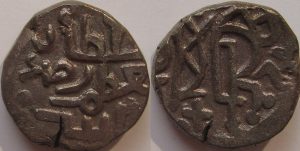Twenty Times As Good As a Man?–Sultan Raziya
[WARNING: For the next few weeks, it’s going to be all women warriors (and occasionally Women Warriors) all the time here at the Margins as we lead up to my publication date of February 26. I’ll try to keep the My Book! My Book! to a minimum and focus on the stories instead, but I may slip now and then because I’m excited.]
Sultan Raziya (d. 1240) was the only female ruler of the Delhi Sultanate in India. (1) Her coins proclaimed her “Pillar of Women, Queen of the Times, Sultan Raziya, daughter of Shamsuddin Iltumish.” (2)
Raziya was the daughter of the third ruler of the Delhi Sultanate. Her father named her as his successor after the death of his eldest son because he did not think any of his surviving sons had what it took to rule. (By all accounts they were the medieval Muslim equivalent of frat boys, devoted to wine, women and poetry.) In fact, according to contemporary chronicler Minhaj-us-siraj, her father considered her the equal of twenty of his sons combined. (3)
Things went pear-shaped immediately after her father’s death in 1236. The Muslim nobles of the Delhi Sultan, unhappy at the idea of a female ruler–as male nobility often were in traditional cultures(4)—placed on of Raziya’s brothers Rukn on the throne. They effectively got a female ruler anyway, since his mother ruled the kingdom while the new sultan partied.
Rukn ud din Firuz and his mother lasted only six months before they were assassinated and Raziya stepped into power . By all accounts she was a good ruler. She also ruffled feathers. She refused to use the title Sultana, which had connotations of being a royal consort but instead proclaimed herself Sultan. (5) She rode on horseback like a man and wore men’s clothing.
She died on the battlefield four years later, defending her throne against an armed revolt by the Turkish nobility, led by another of her brothers, Muizuddin Bahram Shah.
Minhaj-us-siraj summed up her career with words that would apply to many historical women warriors: “She was endowed with all the qualities befitting a king, but she was not born of the right sex, and so in the estimation of men all these virtues were useless.” Grrr.
(1) Time for a little context: The Delhi Sultanate was founded by Mamluk Turks who invaded from Central Asia. Five successive dynasties ruled large sections of the Indian subcontinent from 1206 until their final defeat by the first Mughal emperor, Babur, in 1526.
(2) Coins are one of our best primary sources for many periods. Something to explore in another post.
(3) The 13th century version of Canadian politician Charlotte Whitton’s often quoted quip that “Whatever women do, they must do twice as well as men to be thought half as good. Luckily, this is not difficult.”
(4) And in not so traditional cultures if the trash talking about the new cohort of female congresswomen is any indication.
(5) She was by no means the first reigning female monarch to describe herself not as a queen but as a female king. The tactic is at least as old as Pharaonic Europe
Heads up! Beacon Press is giving away 20 copies of Women Warriors on Goodreads. Enter here through 2/15: .https://www.goodreads.com/giveaway/show/288662
************
Just a reminder: Pre-order swag for Women Warriors is now available! If you buy the book before February 26 and want women warrior trading cards, a book mark and a signed bookplate, fill out this form: www.beacon.org/warriorspreorder
Just so there’s no confusion:
1. You don’t have to buy the book directly from Beacon: pre-orders from any vendor count
2. If you already pre-ordered, you can still get the swag.
In addition to swag, you also get my thanks. Pre-orders matter.







This was such an interesting post. Her life would make a great movie!
So many amazing stories about women!